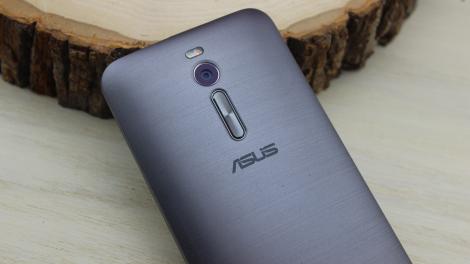
Introduction, design and display
The Asus Zenfone 2 fills an interesting niche as an Android phone full of deep customizations, yet one that sells for half the price of similarly sized phablets.
Typically, Android tinkerers who want to invest a lot of time into customizing their phone also have to pay full price for a flagship. But the Zenfone 2 turns that concept on its meditating head.
At $300 (about £210, AU$408) unlocked and now available in the US, it’s a bargain for a 5.5-inch display that’s as big as a the LG G4 and iPhone 6 Plus, and specs that include a speedy Intel processor and 4GB of RAM.
There’s an even cheaper $200 (about £139, AU$272) model with a slower Intel chip and just 2GB of RAM, but the 4GB version is the one that’s going to last you some time – if it holds up.
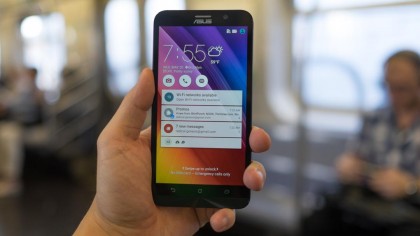
Where Zenfone 2 makes its compromises to hit that price point is in its build quality and camera. It’s easy to spot the flaws of its cheaper plastic construction and poor 13-megapixel sensor.
That said, the Zenfone 2 remains one of the most inexpensive ways to upgrade to Android 5.0 Lollipop with enough processing power leftover, so long as you don’t care about style or feel.
Design
Zenfone 2 is true to its unintentional theme of finding internal strength and beauty because, on the outside, this isn’t a very pretty or strong phone.
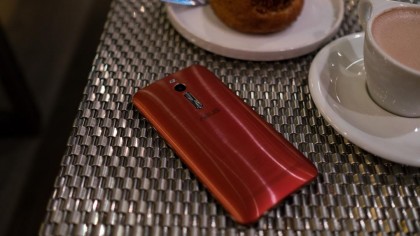
It feels more cheaply made than it looks. This is thanks to the artfully deceptive, brushed metal design on the back cover and its 5.5-inch display made with Gorilla Glass 3 and an anti-glare coating .
But holding the phablet in my stretched out hand, I could tell the difference between it and the glass-backed Samsung Galaxy S6 and aluminum-backed iPhone 6 Plus right away.
I could also see the difference in quality as my stretched out hand accidentally dropped the phone, and its top-right corner met pavement. Cracks spread across the screen’s surface and a frown stretched across my face.
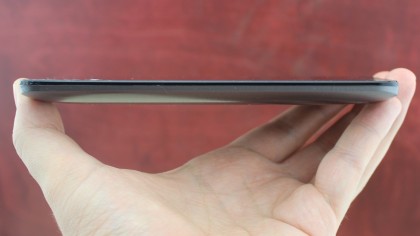
This unintentional drop test was a tumble at 32 inches (81cm), rather than a direct drop, from my pocket. The phone’s bulkier-than-normal dimensions didn’t fit in my jeans as well as I had expected.
While Samsung and HTC upgraded their flagship phones to Gorilla Glass 4, Asus stuck with the previous generation’s less durable material. LG G4 kept Gorilla Glass 3 too, but at least it features a slight curve that might have saved this phone from its now unsightly blemish.
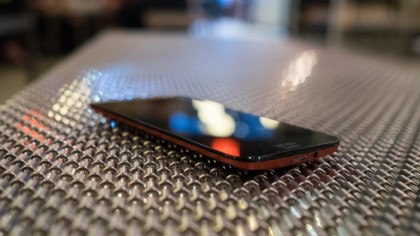
Despite the plastic body and cheaper glass construction, the Zenfone 2’s dimensions and weight are less svelte, as expected given its price.
Its curved back gives it a thickness of 10.9mm. By comparison, the Galaxy S6 is 6.8mm, the HTC One M9 is 9.4mm and the LG G4’s thickest point is 9.8mm.
The rest of the measurements are actually competitive. It’s 152.5mm in length with a 77.2mm width. But, at 170g, it weighs slightly more than everything but the iPhone 6 Plus.
Zenfone 2 also cheaps out on the power button. It sits at the top of the phone, in an odd center location, and has little tactical feedback, almost as if it’s broken. Luckily, the phone’s software makes use of the handy double-tap-to-wake screen feature introduced in the LG G2.
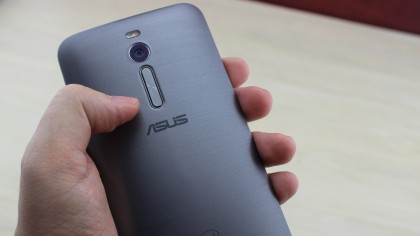
While the power button is annoyingly squishy, the volume buttons have the necessary clicky feedback, taking cues from LG with their location on the back.
Three capacitive buttons for back, home and recent line the bottom of the display, but are neither on-screen buttons, like on some Androids; nor do they light up, like on Samsung devices. This makes it difficult if you’re moving from a Samsung phone (where the back and recent buttons are swapped), as you may have trouble getting used to this order in the dark.
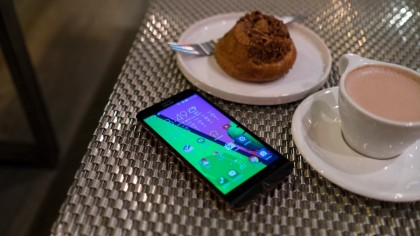
There’s a single loud-sounding speaker, but it stretches across the back of the phone, which means calls on speakerphone and music point in the wrong direction. Costlier phones, like the Galaxy S6, have moved the speaker to the bottom of the phone. Better yet, the HTC One M9 has stereo speakers on the front.
Display
The Asus Zenfone 2 can compete on size, especially for the price. Its large 5.5-inch display, which is slowly becoming the norm among Android phones, feels quite roomy.
Everything from typing out messages to getting work done on the spacious, LED-backlit LCD is a little bit easier, and this phablet has enterprise-ready specs to back up that work.
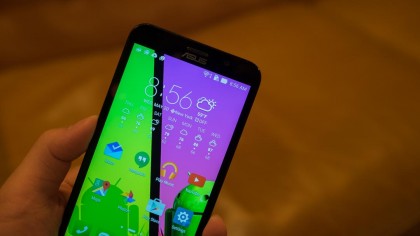
But don’t expect a super-rich screen for fun multimedia. Its diagonal measurement matches the 5.5-inch LG G4, but its resolution of 1,920 x 1,080 cannot compare to a quad HD display.
More importantly, while its the same resolution as the 1080p iPhone 6 Plus, the brightness literally pales in comparison to Apple’s Retina or Samsung’s Super AMOLED displays.
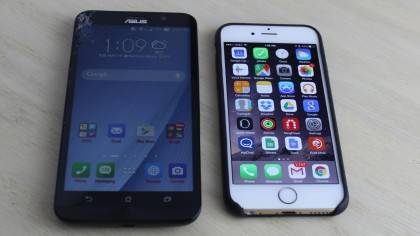
That becomes a real problem when in sunlight. Taking a photo at the sun-drenched beach is nearly impossible when you can’t use the display as a viewfinder. For better or worse, the Zenfone 2 isn’t a great camera phone, so the point is kind of moot anyway.
I do like how, even when selecting the “auto” ambient light mode, the brightness can be adjusted ever so slightly. But overall, the screen looks half as bright as it should be.
Specs, performance and software
This is where the Asus Zenfone 2 shines for its price. Its spec sheet includes an Intel processor, when other major phones boast popular Qualcomm Snapdragon chips at their heart.
The Intel Atom Z3580 quad-core processor is clocked at 2.3GHz, meaning it’s fast enough to handle games and multitasking along with its PowerVR Series 6 G6430 GPU.
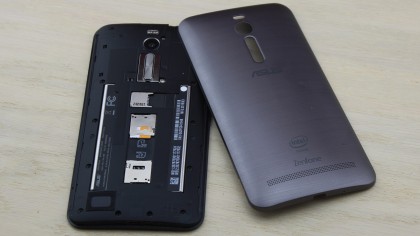
Asus gave its phone some nice overhead when it comes to memory, with 4GB of RAM when almost every other phone tops out at 3GB of memory. The cheaper variant, also a quad-core, is slower at 1.8GHz and 2GB.
Intel’s 2.3GHz quad-core chip and 4GB of RAM combination doesn’t make the new Asus phone the fastest – far from it. But it’s competitive for its mid-range price by beating almost all of last year’s top phones.
Its Geekbench 3 multi-core score of 2,851 outpaces the Galaxy S5, HTC One M8 and OnePlus One, and is just shy of the performance of the Moto X 2014, which hasn’t been refreshed yet.
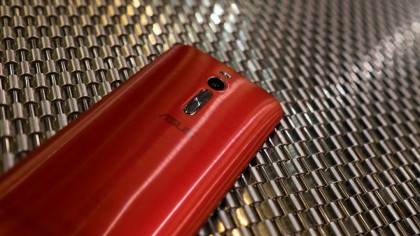
It does trail this year’s flagships, though. Google’s Nexus 6 averaged a 2,986, HTC One M9 scored a 3,005 and the Samsung Galaxy S6 pulled away from the pack with a 4,100 score.
Zenfone 2’s performance is fairly smooth, save for its long 45-second boot up time. And, with 64GB of internal storage (16GB for the cheaper model) and a microSD card slot under the back cover, it’s certainly well equipped for your photos and music.
Call quality, likewise, remained excellent. Though, again, the speaker shouts out of the back of the phone, like too many other smartphones that fail to avoid this pet peeve again and again.
Android 5.0 Lollipop and apps
The Zenfone 2 is a cheap way to upgrade to Android 5.0 Lollipop, if you’re stuck with a phone that hasn’t received (or will not get) Google’s new operating system update yet.
Upon booting up the phone, you wouldn’t really recognize the Material Design theme that the search engine giant created for its Nexus 6 and other stock Android phones. This isn’t a pure Android phone.
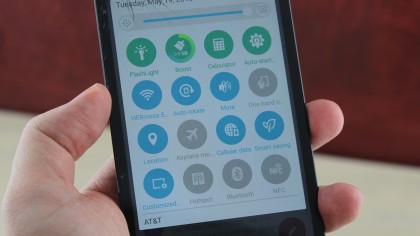
Instead, it has Asus’s ZenUI overlay that cranks up the customization for a more complicated layout, but one that people who root Android phones will appreciate.
The quick settings drop down panel, for example, is chock full of options arranged in a 4 x 4 grid. It’s just two swipes down and one button press to turn on the flashlight or airplane mode.
Best of all, the grid of 12 quick settings can be customized to your liking. Not all Android phones let you tinker with this panel, which is one of many reasons why people end up rooting their phones.
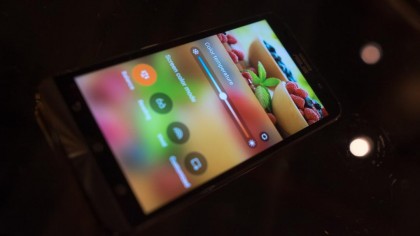
Zenfone 2 gives users control over icon packages, themes, scroll effects between panels, folder icon sizes and styles – heck, even app title font sizes and colors.
There’s even an pre-loaded app called Splendid that let’s you change the color temperature of the phone display ever so slightly, as if it were a TV screen with customizable controls.
There’s an “Easy Mode” within the main settings menu for everyone who doesn’t want all of the complexity of ZenUI. But really, that’s its killer app – thanks to ZenUI, there’s less of a reason to root this phone.
ZenUI apps
Asus also includes over a dozen homegrown apps in addition to the more familiar Google apps that it’s forced to carry with the Android-based Zenfone 2.
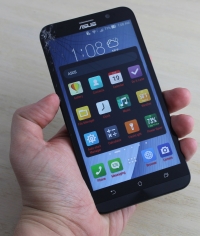
Notably, File Manager provides control over the internal storage and microSD card files, Do It Later supplies an app-integrated task list and flashlight beams out an SOS help signal – just in case.
More fine-tuning of this Android device can be found in Asus’s other ZenUI apps, like Auto-start Manager, Power Saver and Autowizard.
There are also plenty of repeats of what Google already provides: a web browser, gallery app, contacts list, calendar, clock, music, weather, calculator, notes and web storage.
That’s where I ran into a real problem with the ZenUI apps: They can’t be uninstalled from the cluttered Android app launcher menu. They can be hidden or put into smart groups, but wiping them from the interface remains impossible outside of rooting.
Calls and messages
I normally default to Hangouts and don’t mention the phone call app unless there’s something truly novel, and on the Zenfone 2, both messages and the dialer are special.
Both incorporate the dual micro SIM cards into their interface, making it easy to switch back and forth between calling and sending messages between phone numbers.
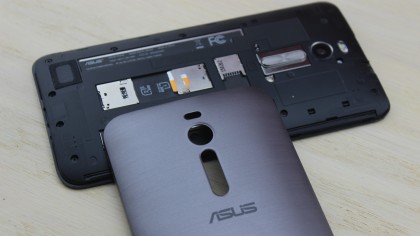
It’s fairly seamless to use when traveling abroad. I can easily imagine eating up cheap data with an international number via SIM 1, but keeping my phone number intact for calls and texts via SIM 2, which can only handle voice and texts.
While there’s no way to seamlessly transition from a phone call to a video call, a feature I do appreciate on the more locked-down iOS within the iPhone 6 Plus, there are some extra buttons when on a call.
Namely, being able to record a phone call is handy for interviews, or if you’re trying to point out horrible customer service to the world. Sending files to the contact while they’re on the line is also a button integrated into this screen.
Camera and battery life
No need to add grain via Instagram with the Zenfone 2. This 13-megapixel camera takes photos that are full of noise, especially in dimly lit locations.
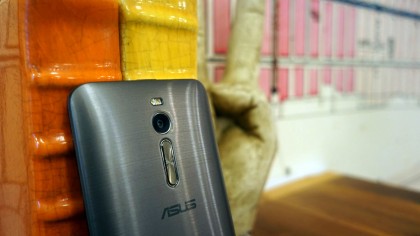
Its tiny, iPhone 5-level 1/3.2-inch sensor size, made by Toshiba, requires ample amounts of light for passable photos, which only look good enough when zoomed all of the way out.
Shots in my local bar, for example, were grainy and muddy all around except for brightly lit neon signs that were completely overexposed. The bright, dual LED flash only does so much.


Testing the Zenfone 2 outdoors isn’t perfect either. Yes, sunlight improves clarity, but the colors are often oversaturated. Its depiction of an aqua blue sky stuck out next to photos of the natural blue, as seen in the Samsung Galaxy S6, iPhone 6 or even cheaper phones, like the Moto X and HTC Desire Eye.


The 5-megapixel camera on the front was no better for selfies, and both cameras take 1080p video at 30 frames per second. Regardless, both lack the fine detail and crispness of today’s standards.
There are some manual controls and modes, from ISO settings (50 to 800) to a selfie mode that takes three photos with the always-superior back camera.


This mode also lets you add the skin-smoothing beautification effect in post, which is nice because too much of that makes everyone’s skin look waxy and fake.
More photos tests are needed in the full hands on, but so far, the camera isn’t the reason to buy the Zenfone 2.
Battery life
Zenfone 2 contains a 3,000 mAh battery, which is larger than the iPhone 6 Plus, Galaxy S6 and HTC One M9 batteries, and it ties the LG G4 battery size.
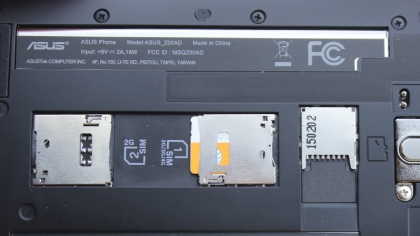
But as we have seen from the poor LG G4 battery performance, a big juice pack doesn’t always equate to all-day battery life. This Asus phone falls in the middle of the pack.
Our battery life tests prove that this Intel-powered device drained 23% while running a non-stop video loop. That ties with other last-generation flagship devices, like the Nexus 5 and the Sony Xperia Z3 compact.
The better news is that, when it really matters, this Zenfone packs a smart saving mode that balances the device’s performance and battery usage.
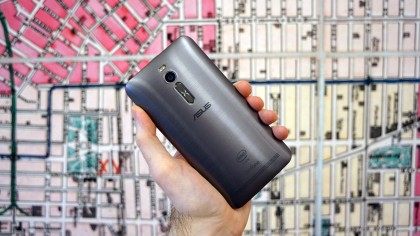
It also charges more quickly than other inexpensive smartphones out there, thanks to Intel’s fast-charging functionality, which is equivalent to Qualcomm’s QuickCharge 2.0.
Sadly, while I could see the battery by taking off the back cover of the phone, it is not user-replaceable. It just peaks out of the back like a big tease.
Camera samples






















Verdict
The Asus Zenfone 2 is like that out-of-shape guy at the gym who pushes harder than anyone would have expected. It’s more powerful than it looks.
But that unsightly build quality proves that, if it’s trying to offer the flagship experience for less, it isn’t quite there yet – and it’s definitely not ready for selfies. *Wince*
We liked
Its best features are a large 5.5-inch display, a solid CPU provided by Intel and 4GB of RAM. The deep ZenUI customization that sits on top of Android 5.0 Lollipop will be a plus for users that want options but don’t know what a ROM is.
We disliked
Zenfone 2 may have inner peace, but its cheap plastic shell doesn’t add up to outer beauty. The display isn’t bright enough for sunny outdoor conditions, which is ironic, because ample light is required to make its shoddy camera’s photos look at least passable.
Final verdict
The Zenfone 2 is half of the price of a top-tier smartphone and offers, thankfully, far more than half the performance. Its power finishes just behind the current pack of best phones.
That said, the screen could be brighter and sharper, the construction could be more durable and less cheap-feeling, and the camera could use retooling.
If the top phones don’t seem worth 600-plus bucks to you – and if you’re better at holding onto a slippery 5.5-inch phone than I am – then parting with $300 (about £210, AU$408) puts this big Android Lollipop phone in your pocket and more money back into your (Google) wallet or purse. It’s that simple – just level your expectations.
![]()
Related Posts
December 6, 2021
7+ Web Design Trends for 2022: Which Will You Use?
December 6, 2021
The 10 Best WordPress Booking Plugins to Use On Your Website
December 6, 2021
How to Use a Web Cache Viewer to View a Cached Page
November 6, 2021
10 Modern Web Design Trends for 2022
November 6, 2021
Best Free SSL Certificate Providers (+ How to Get Started)
November 6, 2021
How to Design a Landing Page That Sends Conversions Skyrocketing
November 6, 2021
What Are the Best WordPress Security Plugins for your Website?
October 6, 2021
Your Guide to How to Buy a Domain Name
October 6, 2021
How to Build a WordPress Website: 9 Steps to Build Your Site
September 6, 2021
10 Best Websites for Downloading Free PSD Files
September 6, 2021
HTML5 Template: A Basic Code Template to Start Your Next Project
September 6, 2021
How Much Does It Cost to Build a Website for a Small Business?
September 6, 2021
A List of Free Public CDNs for Web Developers
September 6, 2021
6 Advanced JavaScript Concepts You Should Know
August 6, 2021
10 Simple Tips for Launching a Website
August 6, 2021
25 Beautiful Examples of “Coming Soon” Pages
August 6, 2021
10 Useful Responsive Design Testing Tools
August 6, 2021
Best-Converting Shopify Themes: 4 Best Shopify Themes
July 6, 2021
What Is Alt Text and Why Should You Use It?
July 6, 2021
24 Must-Know Graphic Design Terms
June 6, 2021
How to Design a Product Page: 6 Pro Design Tips
April 6, 2021
A Beginner’s Guide to Competitor Website Analysis
April 6, 2021
6 BigCommerce Design Tips For Big Ecommerce Results
April 6, 2021
Is WordPress Good for Ecommerce? [Pros and Cons]
March 6, 2021
Make Websites Mobile-Friendly: 5 Astounding Tips
March 6, 2021
Shopify vs. Magento: Which Platform Should I Use?
March 6, 2021
Top 5 Web Design Tools & Software Applications
February 6, 2021
Website Optimization Checklist: Your Go-To Guide to SEO
February 6, 2021
5 UX Design Trends to Dazzle Users in 2021
February 6, 2021
What Is the Average Page Load Time and How Can You Do Better?
February 6, 2021
Choosing an Ecommerce Platform That Will Wow Customers
February 6, 2021
7 Best Practices for Crafting Landing Pages with Forms
February 6, 2021
7 B2B Web Design Tips to Craft an Eye-Catching Website
January 6, 2021
Mobile-Friendly Checker | Check Your Site’s Mobile Score Now
January 6, 2021
8 Tips for Developing a Fantastic Mobile-Friendly Website
December 6, 2020
How to Add an Online Store to Your Website [4 Ways]
December 6, 2020
5 UX Design Tips for Seamless Online Shopping
November 6, 2020
Ecommerce Website Essentials: Does Your Site Have All 11?
November 6, 2020
5 Small Business Website Essentials You Need for Your Site
November 6, 2020
Your Website Redesign Checklist for 2020: 7 Steps for Success
May 1, 2020
Psychology of Color [Infographic]
April 21, 2020
How to start an online store that drives huge sales
January 3, 2020
5 Lead Generation Website Design Best Practices
March 6, 2019
6 Reasons You Should Redesign Your Website in 2019
March 6, 2019
7 Web Design Trends for 2019
February 19, 2019
Who owns the website/app source code, client or developer
February 7, 2019
Don’t Let Your Domain Names Expire in 2019
January 8, 2019
2019 Website Development Trends To Note
October 6, 2017
How Web Design Impacts Content Marketing
October 6, 2017
How to Choose a Navigation Setup
August 6, 2017
Why User Experience Matters to Marketing
July 6, 2017
5 Ways Web Design Impacts Customer Experience
September 6, 2016
How to Learn Angular
September 6, 2016
The Excuses for Not Having a Website (Infographic)
September 6, 2016
How to Build an Award-Winning Web Design Team
September 6, 2016
13 Free Data Visualization Tools
August 6, 2016
How Selling Pastries Helped Us Design a Better Product
August 6, 2016
11 Sites to Help You Find Material Design Inspiration
July 4, 2016
How to change free wordpress.com url
April 6, 2016
The 5 Best Free FTP Clients
April 6, 2016
7 Free UX E-Books Worth Reading
March 6, 2016
Can Handwritten Letters Get You More Clients?
December 10, 2015
Star Wars Week: How to create your own Star Wars effects for free
December 6, 2015
20 "Coming Soon" Pages for Inspiration
December 6, 2015
6 Free Tools for Creating Your Own Icon Font
December 6, 2015
9 Useful Tools for Creating Material Design Color Palettes
November 6, 2015
20 Free UI Kits to Download
November 6, 2015
50 Web Designs with Awesome Typography
November 6, 2015
When to Use rel="nofollow"
November 6, 2015
7 Free Books That Will Help You Become More Productive
November 6, 2015
50 Beautiful One-Page Websites for Inspiration
November 6, 2015
Circular Images with CSS
October 6, 2015
Lessons Learned from an Unsuccessful Kickstarter
October 6, 2015
5 Games That Teach You How to Code
October 6, 2015
Cheatsheet: Photoshop Keyboard Shortcuts
October 6, 2015
An Easy Way to Create a Freelance Contract for Your Projects
October 6, 2015
50 Design Agency Websites for Inspiration
September 29, 2015
JB Hi-Fi shutting the book on ebooks
September 24, 2015
Opinion: Quick, Quickflix: It's time to give yourself the flick
September 24, 2015
New Star Wars 360-degree video is among first on Facebook
September 21, 2015
Apple purges malicious iPhone and iPad apps from App Store
September 12, 2015
Apple's new Live Photos feature will eat up your storage
September 12, 2015
The latest Windows 10 Mobile preview has been delayed
September 12, 2015
IBM buys StrongLoop to add Node.js development to its cloud
September 8, 2015
Fake Android porn app takes your photo, then holds it ransom
September 6, 2015
50 Restaurant Websites for Inspiration
September 6, 2015
Zero UI — The Future of Interfaces
September 6, 2015
50 Beautiful Websites with Big Background Images
September 6, 2015
Infographic: 69 Web Design Tips
September 6, 2015
Free Windows 10 Icons
September 2, 2015
Instagram turns itself into a genuine messaging service
August 11, 2015
In Depth: How Microsoft taught Cortana to be more human
August 11, 2015
Windows 10 price, news and features
August 11, 2015
Windows 10's broken update introduces endless reboot loop
August 11, 2015
Windows 10 races to 27m installs
August 11, 2015
Windows 10 IoT Core gets first public release
August 10, 2015
iOS Tips: How to backup iPhone to an external drive
August 10, 2015
Windows 8.1 RT finally getting Windows 10 Start Menu
August 10, 2015
How to use Windows Hello
August 10, 2015
Review: Moto Surround
August 10, 2015
Review: Moto G (2015)
August 9, 2015
8 of the best free VPN services
August 8, 2015
Use Firefox? Mozilla urges you update ASAP
August 7, 2015
Mac Tips: Apple Mail: How to remove the Favorites Bar
August 7, 2015
How to make the OS X dock appear faster
August 7, 2015
Review: BQ Aquaris E45 Ubuntu Edition
August 7, 2015
Review: Acer Liquid Jade Z
August 6, 2015
How to reinstall Linux
August 6, 2015
How to reinstall Windows
August 6, 2015
Updated: Apple Music: release date, price and features
August 6, 2015
Social News Websites for Front-End Developers
August 6, 2015
10 Free JavaScript Books
August 6, 2015
50 Beautiful Blog Designs
August 6, 2015
Animated SVG Pipes Effect
August 6, 2015
Launching Your First App
August 5, 2015
Windows 10 goes freemium with paid apps
August 5, 2015
Updated: Week 1 with Windows 10
August 5, 2015
Mac Tips: How to manage Safari notifications on Mac
August 5, 2015
Microsoft Sway may kill the PowerPoint presentation
August 4, 2015
Microsoft gives Outlook on the web a new look
August 4, 2015
Mac OS X vulnerable to new zero-day attack
August 4, 2015
Windows 10 users warned of two scams
August 4, 2015
Microsoft's Docs.com is now available to everyone
August 3, 2015
Mac Tips: How to edit the Favorites sidebar on Mac
August 3, 2015
Updated: Windows 10 price, news and features
July 29, 2015
Review: HP ProDesk 405 G2
July 29, 2015
Hands-on review: HP Elite x2 1011
July 29, 2015
Hands-on review: Updated: Windows 10 Mobile
July 29, 2015
Review: Updated: Nvidia Shield Android TV
July 28, 2015
LIVE: Windows 10 launch: Live Blog!
July 28, 2015
How to prepare for your upgrade to Windows 10
July 28, 2015
Review: Updated: Windows 10
July 28, 2015
Review: Updated: HP Pro Tablet 608
July 28, 2015
Review: Heat Genius
July 28, 2015
Hands-on review: Moto X Play
July 28, 2015
Hands-on review: Moto X Style
July 28, 2015
Hands-on review: Moto G (2015)
July 28, 2015
Review: 13-inch MacBook Air (early 2015)
July 28, 2015
Hands-on review: OnePlus 2
July 28, 2015
Review: LG 65EG960T 4K OLED
July 28, 2015
Mac Tips: How to share printers on Mac
July 27, 2015
Apple Music's arrival hasn't opened Pandora's box
July 26, 2015
Review: Garmin Swim
July 25, 2015
How to merge OS X contacts into an existing list
July 25, 2015
Hands-on review: UPDATED: ZTE Axon
July 24, 2015
Mac Tips: How to zoom in on a Mac
July 24, 2015
What Windows 10 means for the enterprise
July 24, 2015
Review: JBL Charge 2 Plus
July 24, 2015
Review: Acer Aspire S7
July 24, 2015
Review: Updated: Canon G3 X
July 24, 2015
Review: Updated: iPad Air 2
July 24, 2015
Review: Thinksound On1
July 24, 2015
Review: Asus Chromebook Flip
July 24, 2015
Review: Garmin Forerunner 225
July 23, 2015
Review: Garmin nuvi 68LM
July 23, 2015
Review: Samsung Galaxy S6 Active
July 23, 2015
Review: Bowers and Wilkins P5 Wireless
July 23, 2015
Review: Dell XPS 15 (2015)
July 21, 2015
Review: Fuji S9900W
July 21, 2015
Review: Updated: Fitbit Surge
July 21, 2015
Review: UE Roll
July 21, 2015
Hands-on review: Ubik Uno
July 20, 2015
Review: Samsung HW-J650
July 20, 2015
Updated: 40 best Android Wear smartwatch apps 2015
July 20, 2015
Review: Acer Chromebook C740 review
July 20, 2015
Review: Huawei Talkband B2
July 20, 2015
Review: Dell Venue 10 7000
July 20, 2015
Review: Intel Core i7-5775C
July 17, 2015
Mac Tips: How to delete locked files on Mac
July 17, 2015
Review: Pebble Time
July 16, 2015
Microsoft just made Windows XP even less secure
July 16, 2015
Windows 8.1 RT is getting an update this September
July 16, 2015
OS showdown: Windows 10 vs Windows 8.1 vs Windows 7
July 16, 2015
Review: Acer CB280HK
July 15, 2015
Windows 10 is ready for new laptops and PCs
July 15, 2015
Explained: How to take a screenshot in Windows
July 15, 2015
Office for Windows 10 appears in latest build
July 14, 2015
Review: ZTE Axon
July 14, 2015
Review: ViewSonic VP2780-4K
July 14, 2015
Hands-on review: SanDisk Connect Wireless Stick
July 14, 2015
Review: Oppo PM-3
July 14, 2015
Review: BT 11ac Dual-Band Wi-Fi Extender 1200
July 14, 2015
Review: Fuji X-T10
July 13, 2015
How to build an SEO strategy for your business
July 13, 2015
Review: Lenovo ThinkPad Yoga 15
July 13, 2015
Review: Audio-Technica ATH-MSR7
July 13, 2015
Review: Garmin NuviCam LMT-D
July 13, 2015
Review: Dell Inspiron 13 7000
July 13, 2015
Hands-on review: AstroPi SenseHAT
July 13, 2015
Hands-on review: EE Rook
July 13, 2015
Hands-on review: Updated: HTC Vive
July 12, 2015
Here's the ultimate software list for PC fanatics
July 10, 2015
How to use the new Photos app for Mac
July 10, 2015
Windows 10 Insider Preview Build 10166 available now
July 10, 2015
Splunk spends big on cybersecurity acquisition
July 10, 2015
Making Windows 10 apps just got a whole lot easier
July 10, 2015
Review: Lenovo LaVie Z 360
July 9, 2015
OS X El Capitan public beta available right now
July 9, 2015
Microsoft finally unveils Office 2016 for Mac
July 9, 2015
Review: Updated: Chromecast
July 9, 2015
Review: Updated: Tesco Hudl 2
July 9, 2015
Review: Lenovo ThinkPad E550
July 9, 2015
Review: Updated: Google Nexus 6
July 8, 2015
What you need to know about Windows Server 2016
July 7, 2015
Microsoft to hike enterprise cloud pricing
July 6, 2015
Hacking Team end up being totally 0wned
July 6, 2015
Review: HP Pro Slate 12
July 6, 2015
Review: Samsung 850 Pro 2TB
July 6, 2015
Review: Asus RT-AC87U
July 6, 2015
Review: Jawbone UP2
July 6, 2015
Reimagining the Web Design Process
July 6, 2015
50 Clean Websites for Inspiration
July 6, 2015
15 Free Books for People Who Code
July 6, 2015
Web Storage: A Primer
July 6, 2015
A Look at Some CSS Methodologies
July 3, 2015
6 Essential Mac Mouse and Trackpad Tips
July 2, 2015
How to install a third party keyboard on Android
July 2, 2015
Review: Alienware 13
July 2, 2015
Review: HP DeskJet 1010
July 1, 2015
5 issues we want Apple Music to fix
June 13, 2015
Cortana will get its own button on Windows 10 PCs
June 12, 2015
Windows 10 will come with universal Skype app
June 12, 2015
iPad music production: 18 Best apps and gear
June 12, 2015
Windows 10 all set for early enterprise struggle
June 12, 2015
Review: Garmin VIRB Elite
June 11, 2015
Review: Updated: Nvidia Shield Tablet
June 11, 2015
Review: Nokia Lumia 635
June 10, 2015
Microsoft brings more online tweaks to Office 365
June 10, 2015
Mac Tips: How to use Screen Sharing in Mac OS X
June 9, 2015
Hands-on review: Meizu M2 Note
June 9, 2015
Hands-on review: EE 4GEE Action Camera
June 9, 2015
Review: Toshiba 3TB Canvio external hard drive
June 9, 2015
Review: Olympus SH-2
June 8, 2015
Hands-on review: Updated: Apple CarPlay
June 8, 2015
UPDATED: iOS 9 release date, features and news
June 8, 2015
Review: Updated: Roku 2
June 8, 2015
Review: Updated: PlayStation Vue
June 8, 2015
Review: Dell PowerEdge R730
June 8, 2015
Review: Canon SX710 HS
June 7, 2015
UPDATED: iOS 9 release date, features and rumors
June 7, 2015
Review: Lenovo S20-30
June 6, 2015
Free Writing Icons
June 6, 2015
15 CSS Questions to Test Your Knowledge
June 6, 2015
The Best CSS Reset Stylesheets
June 6, 2015
How CSS Specificity Works
June 5, 2015
'Delay' is a new feature in Windows 10
June 5, 2015
Review: Beyerdynamic Custom One Pro Plus
June 5, 2015
Latest SEO Marketing tools
June 5, 2015
Review: Nvidia Shield Android TV
June 5, 2015
Review: Honor 4X
June 5, 2015
Review: In Depth: Oppo R5
June 3, 2015
Hands-on review: Huawei P8 Lite
June 3, 2015
How To: How to create eBooks on a Mac
June 3, 2015
Review: Updated: Tidal
June 3, 2015
Review: Canon 750D (Rebel T6i)
June 2, 2015
Review: Updated: Asus ZenWatch
June 2, 2015
Review: Alcatel OneTouch Idol 3
June 2, 2015
Review: Updated: Nokia Lumia 1520
June 2, 2015
Review: Updated: Yotaphone 2
June 2, 2015
Review: Updated: Nokia Lumia 625
June 2, 2015
Review: Creative Muvo Mini
June 1, 2015
Review: Acer TravelMate P645 (2015)
June 1, 2015
Hands-on review: Corsair Bulldog
May 29, 2015
In Depth: NetApp: a requiem
May 29, 2015
July is looking definite for Windows 10 release
May 29, 2015
Hands-on review: Google Photos
May 28, 2015
Mac Tips: The 16 best free GarageBand plugins
May 28, 2015
Review: Canon 760D (Rebel T6s)
May 27, 2015
Review: Lenovo Yoga 3 14
May 27, 2015
Hands-on review: Serif Affinity Photo
May 27, 2015
Review: Garmin Vivoactive
May 26, 2015
Review: Datacolor Spyder5 Elite
May 26, 2015
Hands-on review: Sony Xperia Z3+
May 26, 2015
Review: Epson BrightLink Pro 1410Wi
May 26, 2015
Review: Technics Premium C700
May 26, 2015
Review: Canon EOS M3
May 26, 2015
Review: Updated: HTC One M9
May 26, 2015
Review: Updated: Sony Xperia Z3 Compact
May 25, 2015
Review: Updated: New Nintendo 3DS
May 25, 2015
Updated: 50 best Mac tips, tricks and timesavers
May 25, 2015
Updated: Windows email: 5 best free clients
May 25, 2015
Instagram is planning to invade your inbox
May 25, 2015
Review: Updated: Foxtel Play
May 24, 2015
How Windows 10 will change smartphones forever
May 24, 2015
Review: Vodafone Smart Prime 6
May 24, 2015
Review: Updated: iPad mini
May 22, 2015
Office Now may be Cortana for your work life
May 22, 2015
Review: Updated: Lenovo Yoga 3 Pro
May 22, 2015
Review: Microsoft Lumia 640 LTE
May 22, 2015
Review: Updated: Fitbit Flex
May 21, 2015
Updated: Best free Android apps 2015
May 21, 2015
Review: Asus ZenBook Pro UX501
May 21, 2015
Review: Sennheiser Momentum In-Ear
May 20, 2015
Hands-on review: UPDATED: Asus Zenfone 2
May 20, 2015
OS X 10.11 release date, features and rumors
May 18, 2015
Updated: Best free antivirus software 2015
May 18, 2015
iPhone 6S rumored to launch as soon as August
May 18, 2015
Microsoft ready to pounce and acquire IFS?
May 17, 2015
5 of the most popular Linux gaming distros
May 16, 2015
Review: Acer Chromebook 15 C910
May 16, 2015
Review: Lenovo ThinkPad X1 Carbon (2015)
May 16, 2015
Review: Polk Nue Voe
May 16, 2015
The top 10 data breaches of the past 12 months
May 16, 2015
Hands-on review: Updated: LG G4
May 16, 2015
Review: Updated: Quickflix
May 16, 2015
Review: LG Watch Urbane
May 16, 2015
Review: Razer Nabu X
May 16, 2015
Hands-on review: Updated: Windows 10
May 16, 2015
Review: UPDATED: Moto X
May 16, 2015
Review: Updated: Moto G (2013)
May 12, 2015
Review: TomTom Go 50
May 12, 2015
Review: Updated: Moto G (2014)
May 12, 2015
Review: Garmin Vivofit 2
May 12, 2015
Review: Asus Transformer Book Flip TP300LA
May 11, 2015
Review: MSI GT80 Titan
May 11, 2015
Review: Monster SuperStar BackFloat
May 9, 2015
Review: Updated: Apple Watch
May 7, 2015
5 million internet users infected by adware
May 7, 2015
Review: Updated: New MacBook 2015
May 6, 2015
Android M will be shown at Google IO 2015
May 6, 2015
Review: Epson WorkForce Pro WF-4630
May 6, 2015
Review: Master & Dynamic MH40
May 6, 2015
How to Use Gulp
May 6, 2015
Getting Started with Command-Line Interfaces
May 6, 2015
What It’s Like to Contribute to WordPress
May 6, 2015
Ultimate Guide to Link Types for Hyperlinks
May 6, 2015
11 Things You Might Not Know About jQuery
May 5, 2015
Hands-on review: Updated: PlayStation Now
May 5, 2015
Review: Lenovo ThinkPad Yoga 12
May 5, 2015
Review: Updated: iPad Air
May 5, 2015
Review: Panasonic SZ10
May 5, 2015
Review: Updated: Fetch TV
May 4, 2015
Review: Cambridge Audio Go V2
May 3, 2015
Review: Lightroom CC/Lightroom 6
May 2, 2015
5 of the most popular Raspberry Pi distros
May 1, 2015
Review: PlayStation Vue
May 1, 2015
Hands-on review: Updated: Microsoft HoloLens
April 30, 2015
Build 2015: Why Windows 10 may not arrive until fall
April 29, 2015
The biggest announcements from Microsoft Build 2015
April 29, 2015
Hands-on review: TomTom Bandit
April 29, 2015
Hands-on review: EE Harrier Mini
April 28, 2015
Review: Samsung NX500
April 28, 2015
Hands-on review: LG G4
April 28, 2015
Review: Patriot Ignite 480GB SSD
April 28, 2015
Hands-on review: EE Harrier
April 28, 2015
Review: Linx 10
April 28, 2015
Review: 1&1 Cloud Server
April 26, 2015
Hands-on review: Acer Iconia One 8
April 25, 2015
How to run Windows on a Mac with Boot Camp
April 24, 2015
Dropbox Notes poised to challenge Google Docs at launch
April 24, 2015
Hands-on review: Acer Aspire E14
April 24, 2015
Hands-on review: UPDATED: Valve Steam Controller
April 24, 2015
Review: Acer Iconia One 7
April 23, 2015
Windows 10 just revived everyone's favorite PC game
April 23, 2015
Google opens up Chromebooks to competitors
April 23, 2015
Here's how Outlook 2016 looks on Windows 10
April 23, 2015
Hands-on review: Updated: Acer Liquid M220
April 23, 2015
Hands-on review: Acer Aspire Switch 10 (2015)
April 23, 2015
Hands-on review: Acer Aspire R 11
April 22, 2015
Review: Alienware 17 (2015)
April 22, 2015
Hands-on review: Updated: HP Pavilion 15 (2015)
April 21, 2015
This is how Windows 10 will arrive on your PC
April 21, 2015
Review: iMac with Retina 5K display
April 21, 2015
Review: Epson XP-420 All-in-One
April 18, 2015
Google Now brings better search to Chrome OS
April 17, 2015
Review: Epson Moverio BT-200
April 17, 2015
Review: Pentax K-S2
April 16, 2015
Updated: Android Lollipop 5.0 update: when can I get it?
April 15, 2015
Hands-on review: Updated: Huawei P8
April 15, 2015
Review: SanDisk Ultra Dual USB Drive 3.0
April 15, 2015
Review: Updated: LG G3
April 15, 2015
Review: Updated: LG G3
April 15, 2015
Review: Crucial BX100 1TB
April 13, 2015
iOS 8.4 beta reveals complete Music app overhaul
April 13, 2015
Linux 4.0: little fanfare for a tiny new release
April 13, 2015
Achievement unlocked: Microsoft gamifies Windows 10
April 13, 2015
Best Android Wear smartwatch apps 2015
April 13, 2015
Review: Acer Aspire R13
April 12, 2015
Review: TP-Link Archer D9
April 10, 2015
Microsoft's new browser arrives for Windows 10 phones
April 10, 2015
Review: LG UltraWide 34UC97
April 9, 2015
Office now integrates with Dropbox on the web
April 9, 2015
Now you can buy video games with Apple Pay
April 9, 2015
Updated: iOS 8 features and updates
April 9, 2015
Microsoft's stripped down Nano Server is on the way
April 8, 2015
Skype Translator gets even more features
April 8, 2015
Windows mail services hit by widespread outages
April 8, 2015
Review: UPDATED: Amazon Echo
April 8, 2015
Hands-on review: Dell Venue 10 7000
April 8, 2015
Review: Updated: OS X 10.10 Yosemite
April 7, 2015
Google's GMeet could kill teleconferencing
April 7, 2015
Is Redstone the first Windows 10 update?
April 7, 2015
Next peek at Windows Server 2016 due next month
April 7, 2015
Review: Acer Aspire Switch 11
April 7, 2015
Review: Adobe Document Cloud
April 6, 2015
Hands-on review: Updated: New MacBook 2015
April 6, 2015
Freebie: 100 Awesome App Icons
April 6, 2015
Six Revisions Quarterly Report #1
April 6, 2015
A Modern Approach to Improving Website Speed
April 6, 2015
Disable Text Selection with CSS
April 4, 2015
Review: Nikon D7200
April 3, 2015
Amazon Prime video now streams to any Android tablet
April 3, 2015
Review: Google Cardboard
April 3, 2015
Review: MSI WS60
April 2, 2015
Chrome users can now run 1.3 million Android apps
April 2, 2015
See Windows 10 Mobile running on an Android handset
April 2, 2015
Review: Mini review: Macphun Noiseless Pro 1.0
April 2, 2015
Review: Intel SSD 750 Series 1.2TB
April 2, 2015
Review: BenQ TreVolo
April 2, 2015
Hands-on review: Nikon 1 J5
April 1, 2015
Microsoft launches Windows 10 music and video apps
April 1, 2015
Review: mini review: Sony XBA-H1
December 19, 2014
Review: CoPilot Premium sat nav app
December 19, 2014





























































































































































































































































































































































































































































































































































































